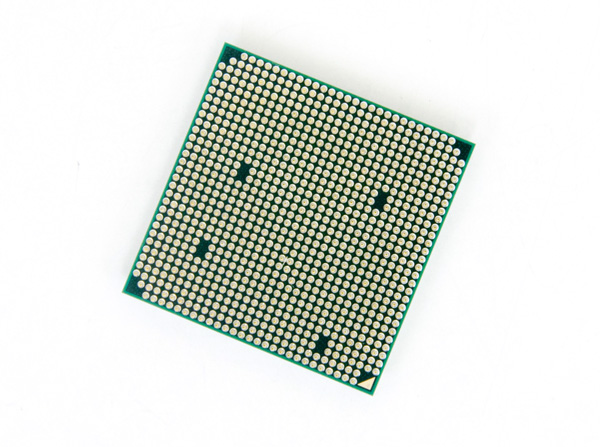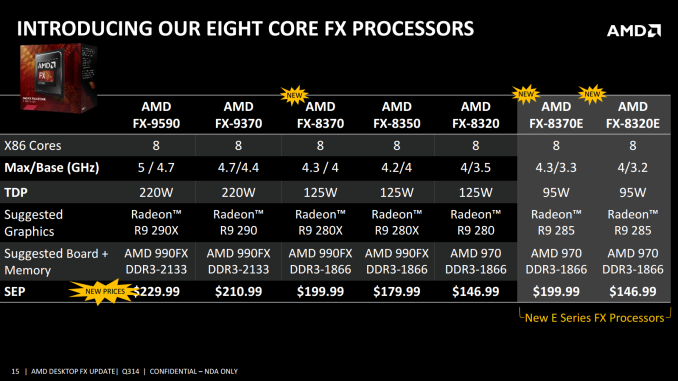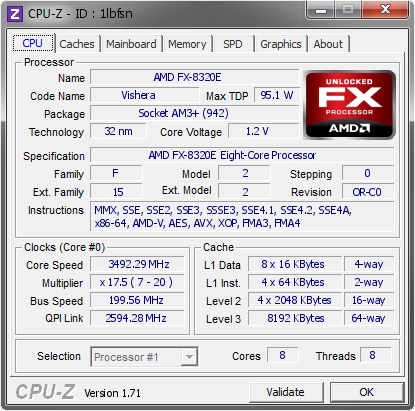AMD FX-8320E CPU Review: The Other 95W Vishera
by Ian Cutress on January 13, 2015 10:00 AM EST
Back in September we reviewed the FX-8370E, a new AMD CPU based on the older Vishera/Piledriver architecture but at a lower power – 95W rather than 125W. This was achieved by a combination of a mature 32nm process, adjusting clock speeds and (potentially) some specifically binned voltage characteristics. The FX-8320E was the other lower power CPU launched that day, which AMD has now been supplying for reviews.
The Information
Part of the world yearns for a new high performance processor from AMD to tackle the market. While Team Blue’s tick-tock model accounts for some of their aggressive product development, the limited success of the Bulldozer architecture put AMD on the back foot. In principle the basic design was a good idea, but the ecosystem to support it was not ready and it was almost left behind by those that focused on the platform metrics already at hand. I say almost, because AMD repositioned their high end product stack based on price to aim to compete on performance, albeit focused on the more mid-range but higher volume market segments, and AMD has not made a new high-end processor based on a new architecture in over two years.
This Vishera platform is based on the Bulldozer-based Piledriver architecture and the 32nm process, but has still produced a number of new models since first launch, including the 220W FX-9000 series coming to retail earlier in 2014 (read our review of the FX-9590 here) and a set of new processors in September 2014. This included the 125W FX-8370, positioned at the top of the FX-8000 range with clock speed increases, and the 95W ‘E’ processors, the FX-8370E and FX-8320E.
These processors are similar to their non-E counterparts, the FX-8370 and FX-8320, but with a lower base frequency but the same turbo frequency. This means, in theory, they should be as quick and responsive for most day-to-day tasks as their 125W brethren, but a bit behind when it comes to the hardcore processor mechanics. While priced the same as the 125W parts, AMD is hoping that the rated TDP reduction will entice users who might not need the full power all the time.
Due to the adjustment of TDP, these processors are also more aimed at the 970 chipset. This is a chipset that uses fewer GPU lanes (one PCIe 2.0 x16 slot, one PCIe 2.0 x4 slot) and is slightly cheaper than the 990FX range. Typically the newer 990FX boards are designed to take the large 220W behemoths from the FX-9000 list, but by using a 970 the motherboard makers can focus on 125W max and hopefully save the customer some money. As a result of this target, AMD also sampled the (anecdotally) most popular 970 board, the MSI 970 Gaming, which we have prepared for a separate review.
With the FX-8320E, it is worth noting that the base frequency is only 300 MHz less than the full-fat CPU. Saving 30W for 300 MHz is usually a good idea for most users, as it usually indicates a better binned CPU. 30W for 300 MHz for overclocking might be par for the course, which means that the FX-8320E might have overclocking potential. On the overclocking front, the FX-8320E is ready to be overclocked with an unlocked multiplier, and we have some interesting results later in the review.
Because the following question comes up repeatedly when coming across the latest in the FX line, I will copy the answer verbatim from our previous FX-8370E review:
“Why update the FX line with more Vishera based processors? Can’t we get an update?
AMD’s reasoning for these new processors, apart from the slowly increasing yields of the higher bin parts over the past year and tweaking the overall design, is because of the motherboards available on the market. Due to the construction of some of the early motherboards intended for AMD’s non-IGP line, these early motherboards could only support 95W or 125W maximum, let alone the 220W of the FX9590/9370 behemoths. By releasing an 8-thread Vishera processor with a 95W TDP, this allows these users to upgrade without spending an extra $120$200 on a new motherboard.”
With regards the old roadmap from AMD, it still looks bleak when we consider the FX CPUs. There is no named successor to Vishera, not even on the 28nm process used for the latest Kaveri APUs:
With the Excavator branded APUs due out at some point in the future, part of me hopes that AMD will release something on the FX line kin to that, but it might have the same issue as the Piledriver/Vishera units in the sense that power consumption spirals upward moving beyond 3.5 GHz without severe binning. The 28nm process was designed more for transistor density, especially when we consider the size of the integrated graphics AMD likes to use on the APUs, so there is debate from AMD's side that if a new FX release would offer much on the CPU side, except higher costs.
AMD stated for our FX-8370E review that ‘The AMD of today is funding the AMD of tomorrow … to ensure the ongoing success of products like FX’. Products like FX. It doesn’t give me hope. With AMD’s Jim Keller being the driving force behind Zen, the pin-compatible x86/ARM processors scheduled for 2016 and as noted in a round table talk, ‘scaling from tablet to desktop’, this is the barrier on the horizon that will focus AMD. But for now, we have 95W Vishera to play with, and our sample was a beast.
The CPU, The Chipset and The DRAM
Straight up, 32nm is up against the wall. Intel is on 14nm, recently releasing both Broadwell-Y (Core M) and Broadwell-U, with the latter up to 28W. This represents Intel’s second generation FinFET technology, and if we recall 32nm was back with Sandy Bridge. That being said, the longer you spend on a process node, the more optimized it can be made and the yields improved. One could argue that this reduces running costs, allowing AMD to get product into the market. The question still remains if it is the right product.
| AMD 900 Series Chipset Comparison | |||
| 990FX | 990X | 970 | |
| Code Name | RD990 | RD980 | RX980 |
| Released | Q2 2011 | Q2 2011 | Q2 2011 |
| Fab (nm) | 65 | 65 | 65 |
| IGP | No | No | No |
| CrossFire | x16 + x16 x8 + x8 + x8 + x8 |
x8 + x8 | x16 + x4 |
| SLI | x16 + x16 x16 + x8 + x8 x8 + x8 + x8 + x8 |
x8 + x8 | No |
| TDP | 19.6W | 14W | 13.6W |
| PCIe | Four PCIe 2.0 slots | Two PCIe 2.0 slots | One PCIe 2.0 x16 slot |
| HyperTransport (MHz) | 2600 | 2600 | 2400 |
From the chipset perspective, AM3+ motherboards come in with either 990FX, 990X or 970 and a choice of two 900 series south bridges. The most common and talked about by far is the 990FX+SB950 combination offering two PCIe 2.0 x16 slots for both CrossFire and SLI, and if you want to splash the cash there are a couple of PLX8747 enabled motherboards that use inter-GPU PCIe 3.0 communication and afford more than two-way setups. However, no matter which way the segment is sliced, there are relatively few new motherboards on the market. Almost all are at least twelve months old, with a select few more recent. We recently reviewed the ASRock 990FX Extreme9 which sits at the top of ASRock’s product stack, but they also released a 990FX Killer with an M.2 SATA slot. ASUS had the 990FX Sabertooth PCIe 3.0 model, or the ROG Crosshair V Formula-Z both at the top of the ranges. MSI’s 970 Gaming has been the talk of the town in recent months, offering a poignant target from them. GIGABYTE has not released a 990FX or 970 Sniper yet, although if the market wants it be sure to let them know.
On a functionality front, the 900 series chipsets suffer from a lack of native USB 3.0, requiring controllers to implement this which can be slower than a native solution. For example the MSI 970 Gaming uses two VLI controllers to give a total of 4 USB 3.0 ports, although the performance is not the best. This typically also adds cost of the controllers to the product, which is something to avoid on a bargain model. On the plus side AMD does have six native SATA 6 Gbps ports, all suitable for RAID.
This Review
So the part in play for this review is the 95W AMD FX-8320E, a quad module/eight thread part with a 3.2 GHz base clock and a 4 GHz turbo mode. Priced at $147 when launched but now available for $150, the main competition from Intel resides from the Core i3-4350 (54W, 2C/4T) at $145 of the Core i3-4370 (54W, 2C/4T) at $160. The data points we have most relevant to this at the time of writing are the FX-8150, FX-8350, Core i3-4130T, Core i3-4330 and Core i3-4360, providing more than enough entertainment.















92 Comments
View All Comments
LeptonX - Tuesday, January 13, 2015 - link
How long do you test with OCCT and what data size? I ask because I often have crashes after 3-6 hours and if I want total stability that lowers my OC by as much as 200MHz.Oxford Guy - Sunday, April 19, 2015 - link
If the chip even lasts that long at an 1.550 volts and what is most likely a temperature well above the rated maximum.bsim500 - Wednesday, January 14, 2015 - link
"Idle to Delta Power Consumption":-"95w" FX-8320E = 86w
"95w" FX-8370E = 127w
"125w" FX-8350 = 163w
"220w" FX-9590 = 272w
And this is precisely why people want the actual idle & load figures not worthless "delta" scores that still do not reflect if, eg, one platform is idling 20w higher than another, etc. It doesn't involve any extra work since you need to acquire both anyway to calculate the delta!
yannigr2 - Wednesday, January 14, 2015 - link
Every time I see charts like these in the article, I am hitting my head on the wall shouting"32nm Thuban. 32nm Thuban you morons!".
Cryio - Wednesday, January 14, 2015 - link
Anandtech guys, please, sometime in 2015 please update the charts with some newer games, that are also CPU dependent.• Tomb Raider is exclusively GPU dependent.
• F1 2013 is old, 2014 was released some time ago. You should still probably benchmark GRID: AutoSport, since it's the newer game with the better optimized engine. F1 games always done poorly with AMD CPUs, for whatever reason.
• Battlefield 4 should be test only on MP. And if you really want to enphasize that CPUs can do in that game, get a HD 7000/R 200 series AMD GPU and run the game on Mantle to see what the CPU can do.
• Get an RTS game on that list.
• Get Far Cry 4, Watch_Dogs, Crysis 3 or Metro Last Light Redux on this list. These are properly CPU hungy games.
Paddockrj - Wednesday, January 14, 2015 - link
Dear members of this channel. You are eating a bull but a fly make you all bleed! AMD created those processors because a lot of people that has Am3+ 95w mobo's need it! If you have a 8120...8150...8320...8350...8370 or FX6xxx, you dont need 8320E or 8370E! AMD created those processor for a good upgrade ONLY.In gaming, FX8320E with a gtx770 or r9 280x gets the same fps that any Intel Core i. Some fps more, some fps less, but the same level. The diference happens when we try to play a Intel optmized game or a game that uses 2 or 4 cores better... MUCH BETTER. 1 core of Intel is better than 1 core of AMD, but we must see that in multicore, FX is excellent. Only i7 2nd or better can face a FX8350 per example in multicore.
But now, the most important perfomance is single core. And this way, Core i3 and i5 4th perform better. However it is not the FX end. I think within two or less years, when 4k be a truth here in Brasil, who have a FX6xxx or better will give thanks God for that. Because 4K uses multicore too much and, I told you all, FX is excellent this track.
We dont need be fanboys, we are getting nothing. I like AMD cause my Phenom 2 x6 + r9 270 run games like an i5 and I pay R$ 1200,00 less at least... More or less = U$ 500,00. That mean, I pay less and I do the same thing. Sure, i5 can convert a film in 30s, my old X6 can do it in 45s, but when I try to convert 2...3...4 films at the same time, X6 can do it in 3minutes, i5 = 5minutes. I lost in single, but in multicore I win. That is matter to me.
All processors has you reason to exist! When people ask me: Ok, multicore is very good, but for gaming? AMD? Why?
I can answer using this example. A lot of people say: I will buy an i5 4430 and a gtx750... or r7 250 or 7750... or 7730... MAN! Why? Oh God! Why?
You must see that NOTHING... Read it well: NO-THING is more important than graphics card in gaming. If you will use a 7870 or r9 270 or gtx760 and want use this build over and over and over and over... Why dont you buy an FX6300 + mobo withi usb3, 1600mhz memory support? = R$650... But no! Intel is VERY VERY VERY HIGH MUCH ULTRA MAXED MAJOR... They think this way. Thinking this way, they buy an i3 4150 + mobo B85 = R$707...
Ok... "tell me the diferences, man!"
i3 will win fx6300 in single core test...
i3 will convert film faster if the program use 2 cores (rare!)
i3 will have 5fps more in some cases
i3 will lose in multicore test
i3 will suffer in 4K
i3 will cost more
And now I ask you: Why pay R$60 plus to do the same thing? With the same quality?
I cant find a usual answer...
JumpingJack - Thursday, January 15, 2015 - link
So what you are saying is that AMD's higher end desktop processors are essentially competitive with Intel low end desktop processors. No wonder they are cheaper.BrokenCrayons - Thursday, January 15, 2015 - link
I consulted my fortune cookie and zodiac to find out that delta charts for power are still pointlessly useless.corsa - Friday, January 16, 2015 - link
PCMark8 v2 OpenCLThe only Benchmark that has no scores for the Blue Team, were they to embarrassing to publish Ian?
Oscarcharliezulu - Sunday, January 18, 2015 - link
What's up with agisoft? Your link http://www.agisoft.ru shows an info box page saying they haven't plaid their hosting bills.